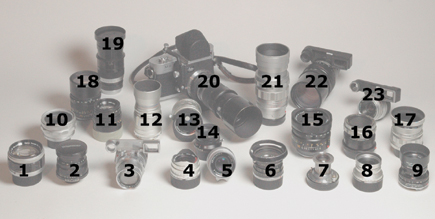You Can’t Use Old Lenses On Digital Cameras! Or Can You? An Extensive Test With The Leica M8 Just Might Change Your Thinking
"My" Leica M8--a loaner from Leica for review--came with a 50mm f/2 bar-coded Summicron. The 18x27mm sensor turns this into a 67mm lens in 35mm terms: rather long for someone whose standard lens on 35mm has for decades been a 35mm. So as soon as I got the M8, I started using other, older lenses. There is, after all, an enormous choice, from 12mm (18mm equivalent) to 135mm (180mm equivalent) and beyond if you use the Visoflex reflex housing, which works as well on an M8 as any other Leica M except the M5.
Admittedly, I already had some experience of "old bottles on new boxes" with my Nikon D70, where I had tried a wide range of Nikon-fit lenses from my 14mm Sigma to my 600mm Vivitar Solid Cat (21-900mm equivalents with Nikon's 1.5x multiplier). I'd like to try a modern Pentax digital camera, too. These can accept any M42 lens (42x1mm thread) ever made: I'd love to try my 135mm f/1.8 Porst (Soligor), among others.
In fact, most cameras can be made to accept most lenses via off-the-shelf or custom-made adapters, though it is as well to avoid the ones with built-in negative optical elements to compensate for back focus. These do nothing for image quality: with small sensors, this is all the more important.
 |
|
|
|
 |
Why, though, would anyone use old lenses on modern digital cameras? Well, you may already own them, or be more easily able to afford them, but you may also want a "look" that is difficult or impossible to re-create otherwise. Although most modern lenses are well above what I call the "quality threshold," where minor changes in technical quality are trivial next to variations in the photographer's ability, there are all kinds of discontinued lenses, good or bad in their day, with unique "signatures."
You may also find it interesting and instructive to try the same lens on both film and digital. With the exception of Leicas (and you can always use Voigtländers for Leica-fit lenses), good-quality secondhand film camera bodies are often available absurdly cheap, and there is no doubt that film and digital each have a very different "look," especially in black and white.
With all this in mind, I surveyed the Leica-fit lenses in my possession, and contacted my old chum Senggye ar Born to borrow some of his. Between us, we came up with two dozen lenses.
 |
|
|
As the brief notes in the sidebar show, many were unexpectedly useful on the M8, while others were ho-hum. My observations may prove useful when you try your own elderly lenses on digital, whether Leica or some other make.
In the real world, once you are above the "quality threshold," it seldom matters very much which lens you use unless it gives you a special "look" or "signature." Often, I couldn't tell which lens I had used for a particular shot, though equally, "signatures" were very clear with the 50mm f/1.2 Canon and the 90mm f/2.2 Thambar.
Then again, part of a "signature" is often color balance, and with manual white balance you can bring the color renditions of all your lenses closer together, including even uncoated ones. And although contrast adjustment in Photoshop can never duplicate the effect of a contrastier lens, it can greatly ameliorate the flatness of old tele or uncoated lenses.
 |
|
|
Because you can change the ISO equivalent so quickly and easily, for a single shot if need be, the M8 can be used very differently from a film camera. Lens speed therefore matters less, unless you are constantly shooting in low light. The focal length multiplier is irksome, because there are no fast, wide lenses equivalent to my beloved 35mm f/1.4 Summilux. This would be a 26mm (call it 25 or 24mm), which even at f/2 would be pretty big if it had to cover full-frame 35mm as well as 18x27mm.
Ultra wides (15mm, 21mm) really come into their own, with the ISO equivalent turned up when you need more speed. But if I had a 25mm f/2.8 Zeiss Ikon (33mm equivalent), it might well become my "standard" M8 lens.
- Log in or register to post comments
















































